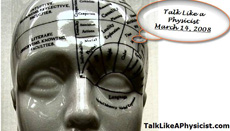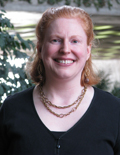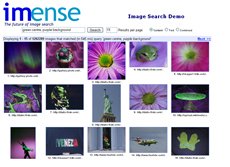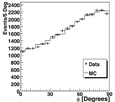|
Reminder:
An IDES representative will conduct small group meetings every 30 minutes in the Wilson Hall One East conference room (NE corner) each Friday from 11 a.m. to 1:30 p.m. from today through the end of March.
New furlough information, including an up-to-date Q&A section, appears on the furlough Web pages daily.
|
|
Friday, March 14
3:30 p.m.
DIRECTOR'S COFFEE BREAK - 2nd Flr X-Over
4:00 p.m.
Joint Experimental-Theoretical Physics Seminar - One West
Speaker: J. Coleman, Stanford Linear Accelerator Center
Title: New Results on Charm Mixing from BaBar
Saturday, March 15
8 p.m.
Fermilab Arts Series - Ramsey Auditorium
Tickets: $25/$13
Cherish the Ladies
Monday, March 17
2:30 p.m.
Particle Astrophysics Seminar - One West (NOTE LOCATION)
Speaker: S. Watson, University of Michigan
Title: Cosmological Dark Matter and LHC: How Robust is the Connection?
3:30 p.m.
DIRECTOR'S COFFEE BREAK - 2nd Flr X-Over
4 p.m.
All Experimenters' Meeting - Curia II
Click here for NALCAL,
a weekly calendar with links to additional information. |
Friday, March 14
- Caldo De Camaron
- Portabello mushroom melt
- Southern fried chicken
- Tuna casserole
- Eggplant parmesan panini
- Assorted pizza slices
- Assorted sub sandwich
Wilson Hall Cafe Menu |
|
Wednesday, March 19
Lunch
- Trout almondine
- Lemon scented rice
- Vegetable of the season
- Amaretto cheesecake
Thursday, March 20
Dinner
- Seviche
- Paella
- Watercress, oranges & red onion salad
- Brazo de gitano
Chez Leon Menu
Call x4598 to make your reservation. |
|
|
A trifecta holiday for
the left-brain crowd

Not all careers are created equal in the realm of public appeal. Athletes get the glory. Politicians get yard signs.
But do they have their own day? Naaawww..
But you do.
Today marks the first observance of Talk Like a Physicist Day. The new holiday will crowd onto March 14 along with Albert Einstein's birthday and International Pi Day to create a trifecta event for the left-brain crowd.
You have a whole day, freely, and with pride, to talk in algorithms and spew esoteric engineering terms about machines that exist in only a few places on the globe.
The idea grew from a challenge thrown out by Jennifer Ouellette, author of "The Physics of the BuffyVerse," in her blog Cocktail Party Physics. Musing on the fact that Talk Like a Pirate Day exists, Ouellette dared the world's modern-day explorers to choose a day on the calendar to take their own linguistic liberties.
A new Web site picked up the challenge, announcing it's ready to take physics-quality phrase submissions to launch the new holiday.
So have fun. Use as much jargon as possible. Revel in laboratory lexicons. Strive to turn arcane physics-speak into the terminology of the uber hip.
In the spirit of cross-checking data, send Fermilab Today as well as Talk Like a Physicist the best phrases you hear today, and we'll run them in a future issue.
If you need a little help getting in the celebratory mood, here's a song about Pi.
--Tona Kunz
|
Ginny Stack is here to help
 |
| Ginny Stack |
Those who visit the Employee Assistance Program office on the 15th floor will now see a new face. Virginia "Ginny" Stack took over this week for former EAP counselor Brian Malinowski, who was promoted within the organization.
"It has been a seamless transition," said Equal Opportunity Office manager Dianne Engram.
Stack, a licensed clinical, professional counselor, has owned her own practice for more than 20 years. She currently practices in Downers Grove.
Stack is the on site representative for VMC/Horizon, the company that runs Fermilab's EAP Program. She will have office hours on Monday afternoons, from 1-5 p.m. and Wednesday mornings, from 9 a.m. - 1 p.m. You can find her in the northwest corner of the 15th floor of Wilson Hall. Walk in if her door is open and she isn't with anyone. To make an appointment during office hours, employees can contact Stack at x3591 or via e-mail. For assistance at any other time, call EAP representatives 24/7 at (800) 843-1327.
|
The business of grid computing: "What can grids do for you?"

Imense Ltd, of Cambridge, England, use gLite middleware to run their content-based image retrieval technology. This particular result came from a search for "green centre, purple background."
Image courtesy of Imense Ltd
EGEE, Europe's largest grid for a wide range of applications, is working with industry to help new businesses and old to capitalize on the open source grid technologies already developed.
Stephanie Parker, who chairs EGEE's Industry Forum, says grids have a lot to offer. "The biggest selling point is that grids can save you money: companies can access more computing power without shelling out for new hardware. Grid delivers major value by improving business performance, by helping to get products to market faster, and by enabling companies to do new things."
Read more
-- Danielle Venton, EGEE
|
Is the future of American science at risk?
From Medill News Service,
March 12, 2008
Recent funding cuts made by Congress are already reducing operations at Argonne National Laboratory and the Fermi National Accelerator Laboratory (Fermilab), two Chicago area labs at the heart of national research.
But the cuts may also limit America's contributions to science in years to come, according to the directors of both labs. Argonne is a multi-purpose research lab while Fermilab searches for the fundamental building blocks of matter.
Scientific discoveries often take decades to enter mainstream use, explained Argonne director Robert Rosner.
"The laser was first developed in 1960," he said. "If you ask yourself, 'When did it become industrially important?' The answer is the 1990s."
The squeeze at Argonne and Fermilab today could mean some future technologies will be developed elsewhere - possibly outside the United States.
Read more
|
|
|
KTeV directly measures neutral pion parity


The angular distribution of the decay of a neutral pion to two electrons and
two positrons. Left: The distribution published by N.P. Samios et al. in
1962. Right: The distribution obtained by KTeV. The solid line is the
prediction for negative parity.
The parity of a particle is one of its fundamental quantum properties. Its value, like electric charge, can be either positive or negative. Parity also describes the difference between your left hand and your right hand: the reflection of your left hand in a mirror is identical to your right hand.
When a subatomic reaction remains unchanged when watched in a mirror, the total parity of this system of particles is conserved. According to the Standard Model, reactions involving the strong and electromagnetic forces conserve parity; reactions involving the weak force do not.
The KTeV collaboration at Fermilab, using data collected from 1997 to 2000, has now obtained the world's best result on the parity of the neutral pion. Pions are particles that act as the glue that holds protons and neutrons together in a nucleus. The Standard Model predicts and indirect measurements have indicated that neutral pions have negative parity. KTeV's direct measurement now conclusively confirms the negative parity of the neutral pion with over 20 standard deviations.
The direct measurement of the neutral pion's parity is difficult. The only known method relies on the decay of a pion to two electrons and two positrons, also known as the "double Dalitz" decay (named after the late physicist Richard Dalitz, who first predicted this class of decays). Each electron forms a "Dalitz pair" with one of the positrons, and each pair represents a two-dimensional plane in space, defined by the directions of the two particles. If the pion has negative parity, the planes of the two Dalitz pairs will be perpendicular to each other more often than they are parallel. If the pion has positive parity, the planes will prefer to be parallel.
The double Dalitz decay rarely occurs: only one pion in 30,000 decays in this way. Prior to the KTeV experiment, the last measurement of this decay was in 1962 when a bubble chamber at Columbia University's Nevis Cyclotron recorded 200 "double Dalitz" events. Based on 112 analyzable events, the experimenters at Columbia found that the data favored negative parity with a statistical significance of three to four standard deviations. Their result has been one of the oldest results in high-energy physics that physicists had not been able to improve upon.

Left to right: Tony Barker (deceased), Patrick Toale
and Eric Zimmerman of the University of Colorado.
Read more
Read the associated paper
Result of the Week Archive
|
Gates calls on Congress to fund education, research
From Macworld,
March 12, 2008
Speaking before the U.S. House Committee on Science and Technology on Wednesday, Microsoft Chairman Bill Gates outlined suggestions to build U.S. strength in an increasingly competitive international high-technology market.
Gates suggestions include improving science and math education for U.S. students. Unless more students can be attracted to science and math, Gates warns, the U.S.'s competitive advantage will erode and its ability to create high-paying jobs will suffer.
Read more
|
Unix Web service meeting
The CD Central Services Group will hold a central Unix Web service town meeting on Wednesday, March 19, to get input on web needs and long term web service direction.
We'd like to hear your ideas about Web service
additions or changes you would like to see supported.
We'd also like to know your preference for Solaris or Linux Web service. This choice will affect almost all central CGI authors. A demo
of the new Web site traffic statistics reporting software will also happen.
For more information, please see the announcement. If you cannot attend, but would like to contribute,
please fill out the survey by March 30.
-- CD/LSC/CSI/CSG Web Team
|
|
Have a safe day!
IDES representative on site Friday
An IDES representative will be on site in the Wilson Hall One East conference room (NE corner) Fridays through the end of March. Small group meetings will occur every 30 minutes, beginning at 11 a.m. and ending with a final meeting at 1 p.m. If you are beginning your furlough week, please fill out a benefit application on site. You may also apply for benefits online or at your local IDES office the week you are on furlough. Please contact Heather Sidman x3326 or Jeannelle Smith x4367 with questions.
Discounted tickets available
Discounted tickets are available for the Chicago Bulls at the United Center, March 22, $26 and March 25, $30. Stop by the Recreation Office, WH15, or call x2548 for more information.
Folk Club barn dance Sunday
Fermilab Folk Club barn dance Sunday, March 16 at 2 p.m. with music by Danny Miller & Friends and calling by Dan Saathoff. More information.
Classifieds
New classified ads have been posted on Fermilab Today.
Additional Activities
|
|